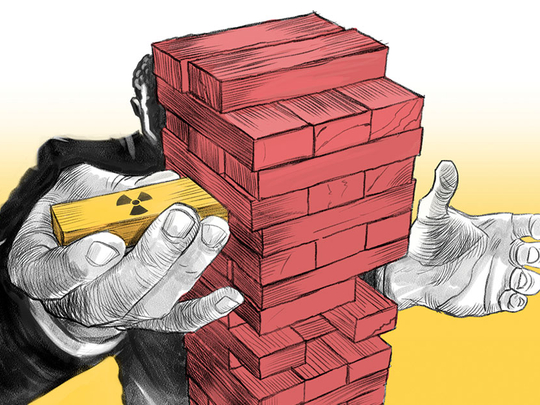
Opponents of the nuclear agreement with Iran see it as a license for Tehran to wreak havoc in the region. Freed from economic pressure and flush with financial resources, the thinking goes, Iran can be expected to unleash its emboldened minions upon Israel and Arab states and undermine US interests. However, contrary to what the critics say, the nuclear deal is far more likely to curb Iran’s regional ambition. It is rather the instability that would follow the failure of the deal that should worry them.
Iran spent $15 billion (Dh55 billion) on its military last year. By comparison, Saudi Arabia spent $80 billion, and the five other states of the Gulf Cooperation Council (GCC) spent another $35 billion. The Arab countries most worried about Iranian mischief outspent Iran by a margin of 8 to 1. Iran does not have an air force, and its ground forces and navy lag technologically behind its rivals. The nuclear deal will only widen this gap. At a summit at Camp David in May, US President Barack Obama promised GCC countries more military hardware and assistance to improve their ability to police the region. Meanwhile, under the terms of the nuclear deal, Iran would have to wait another five years for a UN-imposed arms embargo to be lifted.
The deal does relieve economic pressure on Iran, but not enough to change the balance of power in the region. US Secretary of State John Kerry has estimated that after Iran has paid its creditors, the financial windfall resulting from the deal would be no more than $50 billion to $60 billion, a good portion of which will have to go to Iran’s domestic needs.
In the past, Iran has compensated for its deficit in conventional military spending by deploying a network of armed militias trained, financed and managed by its Revolutionary Guards. It is through this asymmetric capability that Iran has menaced Israel on its borders, bolstered its position in Iraq and sustained the Al Houthi rebellion in Yemen on Saudi Arabia’s flank.
This end run around the regional military balance is sustainable if protected by a nuclear umbrella. As with Pakistan’s use of the same strategy against India, asymmetric provocation works only if there is deterrence against costly retaliation. Without it, Iranian provocations would invite repetitions of Israeli retaliatory operations in South Lebanon and Gaza or Saudi Arabia’s war in Yemen.
By signing the nuclear deal, Iran has given up that nuclear umbrella for as long as two decades and made the case for the United States to further strengthen the conventional military capacities of Israel and the GCC. Contrary to what opponents say, the nuclear agreement has weakened Iran and strengthened its regional rivals.
Regional agenda hobbled
So why did Iran sign on to a deal that will undermine its regional strategy? The obvious answer is that economic sanctions forced Iran to choose between political stability at home and hegemony over the region. On that score, then, the nuclear deal has in one swoop ended Iran’s nuclear threat and hobbled its regional agenda.
But equally important is that Iran’s main regional worry has become Daesh (the self-proclaimed Islamic State of Iraq and the Levant). The extremist Sunni force has emerged as an anti-Shiite and anti-Iranian juggernaut that now controls vast territory in Iraq and Syria and is a growing presence in Afghanistan. Daesh has the potential to expand into other Arab states and thereby present Iran and its Shiite allies with a significant strategic threat.
Iran has been fighting Daesh in Iraq and Syria, and it could be doing the same in Afghanistan before long. This could be a long war, and that reality has forced Iran to rethink its strategic calculus. Confronting Daesh requires not a nuclear umbrella but a reduction of tensions with the international community and greater economic resources. The threat of Daesh, more so than any promise of hegemony over the region, was likely a decisive factor in Iran’s decision to sign away the nuclear cover for its regional strategy.
The US is not openly collaborating with Iran in fighting Daesh, and, along with Turkey and the GCC countries, Washington remains critical of Tehran’s support of the Al Assad regime in Syria. Still, the US and its allies would want Iran to continue to press against Daesh in Syria as well as in Iraq.
Opponents of the nuclear deal imagine a scenario in which the deal could be scuttled, leaving Iran further isolated and under more economic sanctions and its regional capacity diminished — even as it continues to lead the fight against Daesh. That is unlikely. Rather, Iran could respond to the collapse of the deal by doubling down on its nuclear programme while increasing regional tensions and also passing a greater burden of fighting Daesh to Washington and its allies.
Iran would still fight Daesh to protect Shiite population centres and holy sites in Iraq, along with Damascus and Alawite strongholds in Syria, but it could back away from challenging it for control of Iraq and Syria’s Sunni regions. It would be left to the United States and its allies to fight for Ramadi, Mosul and other Sunni areas.
Torpedoing the nuclear deal would not be simply a reset to where things stood before talks started in 2013, and it would not play to America’s advantage. To the contrary, the US would be confronted with the task of managing the challenge of an Iran using a newly acquired nuclear umbrella to establish its imprint on the region, while having to stop Daesh from establishing control over the Levant on its own. That’s what should worry the US and its allies.
— Washington Post
Vali Nasr is dean of the School of Advanced International Studies at Johns Hopkins University.












